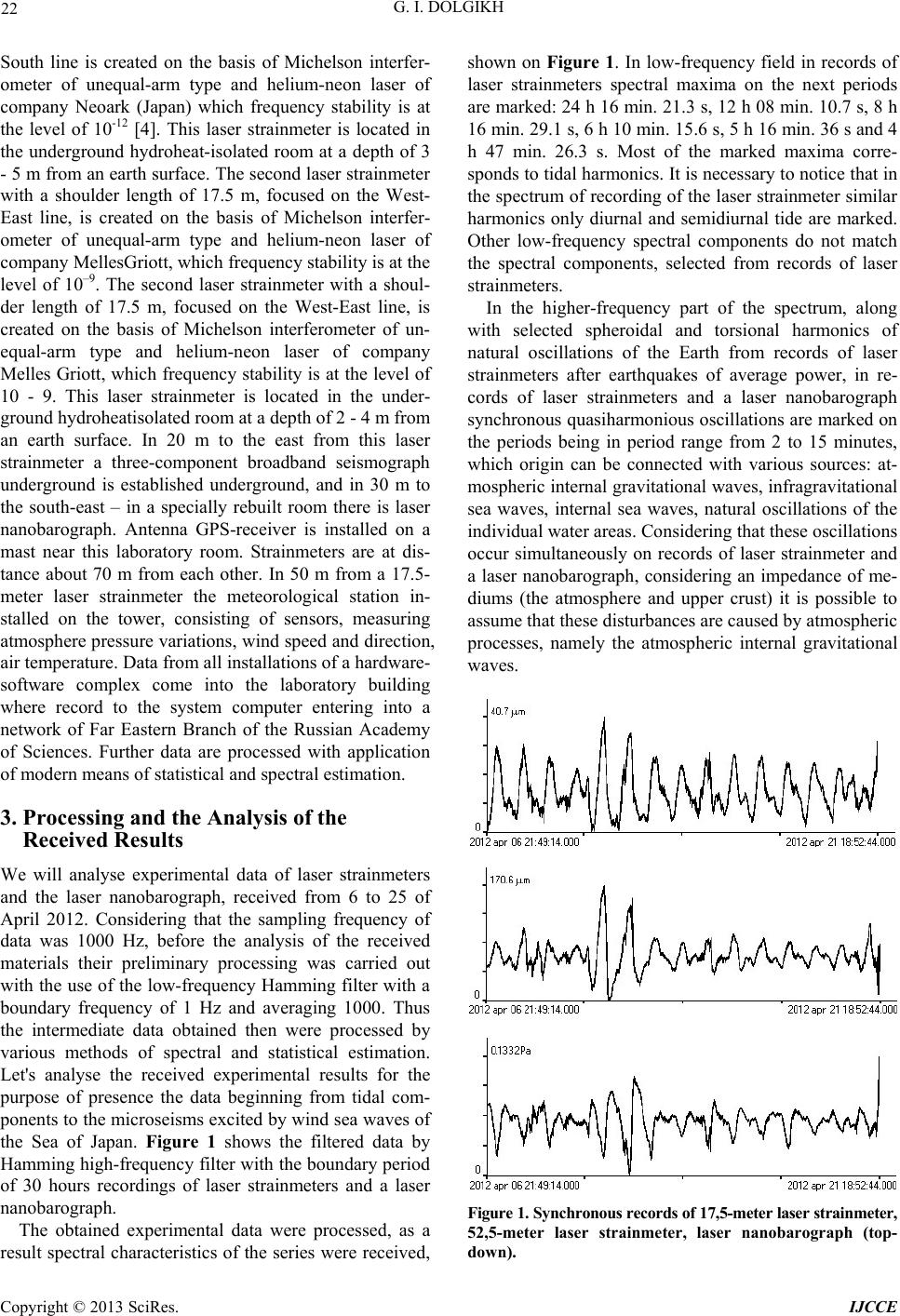
G. I. DOLGIKH
22
South line is created on the basis of Michelson interfer-
ometer of unequal-arm type and helium-neon laser of
company Neoark (Japan) which frequency stability is at
the level of 10-12 [4]. This laser strainmeter is located in
the underground hydroheat-isolated room at a depth of 3
- 5 m from an earth surface. The second laser strainmeter
with a shoulder length of 17.5 m, focused on the West-
East line, is created on the basis of Michelson interfer-
ometer of unequal-arm type and helium-neon laser of
company MellesGriott, which frequ ency stability is at th e
level of 10–9. The second laser strainmeter with a shoul-
der length of 17.5 m, focused on the West-East line, is
created on the basis of Michelson interferometer of un-
equal-arm type and helium-neon laser of company
Melles Griott, which frequency stability is at the lev el of
10 - 9. This laser strainmeter is located in the under-
ground hydroheatisolated room at a depth of 2 - 4 m from
an earth surface. In 20 m to the east from this laser
strainmeter a three-component broadband seismograph
underground is established underground, and in 30 m to
the south-east – in a specially rebuilt room there is laser
nanobarograph. Antenna GPS-receiver is installed on a
mast near this laboratory room. Strainmeters are at dis-
tance about 70 m from each other. In 50 m from a 17.5-
meter laser strainmeter the meteorological station in-
stalled on the tower, consisting of sensors, measuring
atmosphere pressure variations, wind speed and direction,
air temperature. Data from all installations of a hardware-
software complex come into the laboratory building
where record to the system computer entering into a
network of Far Eastern Branch of the Russian Academy
of Sciences. Further data are processed with application
of modern means of statistical and spectral estimation.
3. Processing and the Analysis of the
Received Results
We will analyse experimental data of laser strainmeters
and the laser nanobarograph, received from 6 to 25 of
April 2012. Considering that the sampling frequency of
data was 1000 Hz, before the analysis of the received
materials their preliminary processing was carried out
with the use of the low-frequency Hamming filter with a
boundary frequency of 1 Hz and averaging 1000. Thus
the intermediate data obtained then were processed by
various methods of spectral and statistical estimation.
Let's analyse the received experimental results for the
purpose of presence the data beginning from tidal com-
ponents to the microseisms excited by wind sea waves of
the Sea of Japan. Figure 1 shows the filtered data by
Hamming high-frequency filter with the boundary period
of 30 hours recordings of laser strainmeters and a laser
nanobarograph.
The obtained experimental data were processed, as a
result spectral characteristics of the series were received,
shown on Figure 1. In low-frequency field in records of
laser strainmeters spectral maxima on the next periods
are marked: 24 h 16 min. 21.3 s, 12 h 08 min. 10.7 s, 8 h
16 min. 29.1 s, 6 h 10 min. 15.6 s, 5 h 16 min. 36 s and 4
h 47 min. 26.3 s. Most of the marked maxima corre-
sponds to tidal harmonics. It is necessary to notice that in
the spectrum of recording of the laser strainmeter similar
harmonics only diurnal and semidiurnal tide are marked.
Other low-frequency spectral components do not match
the spectral components, selected from records of laser
strainmeters.
In the higher-frequency part of the spectrum, along
with selected spheroidal and torsional harmonics of
natural oscillations of the Earth from records of laser
strainmeters after earthquakes of average power, in re-
cords of laser strainmeters and a laser nanobarograph
synchronous quasiharmonious oscillatio ns are marked on
the periods being in period range from 2 to 15 minutes,
which origin can be connected with various sources: at-
mospheric internal gravitatio nal waves, infragravitational
sea waves, internal sea waves, natural oscillations of the
individual water areas. Considering that these oscillatio ns
occur simultaneously on records of laser strainmeter and
a laser nanobarograph, considering an impedance of me-
diums (the atmosphere and upper crust) it is possible to
assume that these disturbances are caused by atmospheric
processes, namely the atmospheric internal gravitational
waves.
Figure 1. Synchronous recor ds of 17,5-mete r laser str ainme ter,
52,5-meter laser strainmeter, laser nanobarograph (top-
down).
Copyright © 2013 SciRes. IJCCE